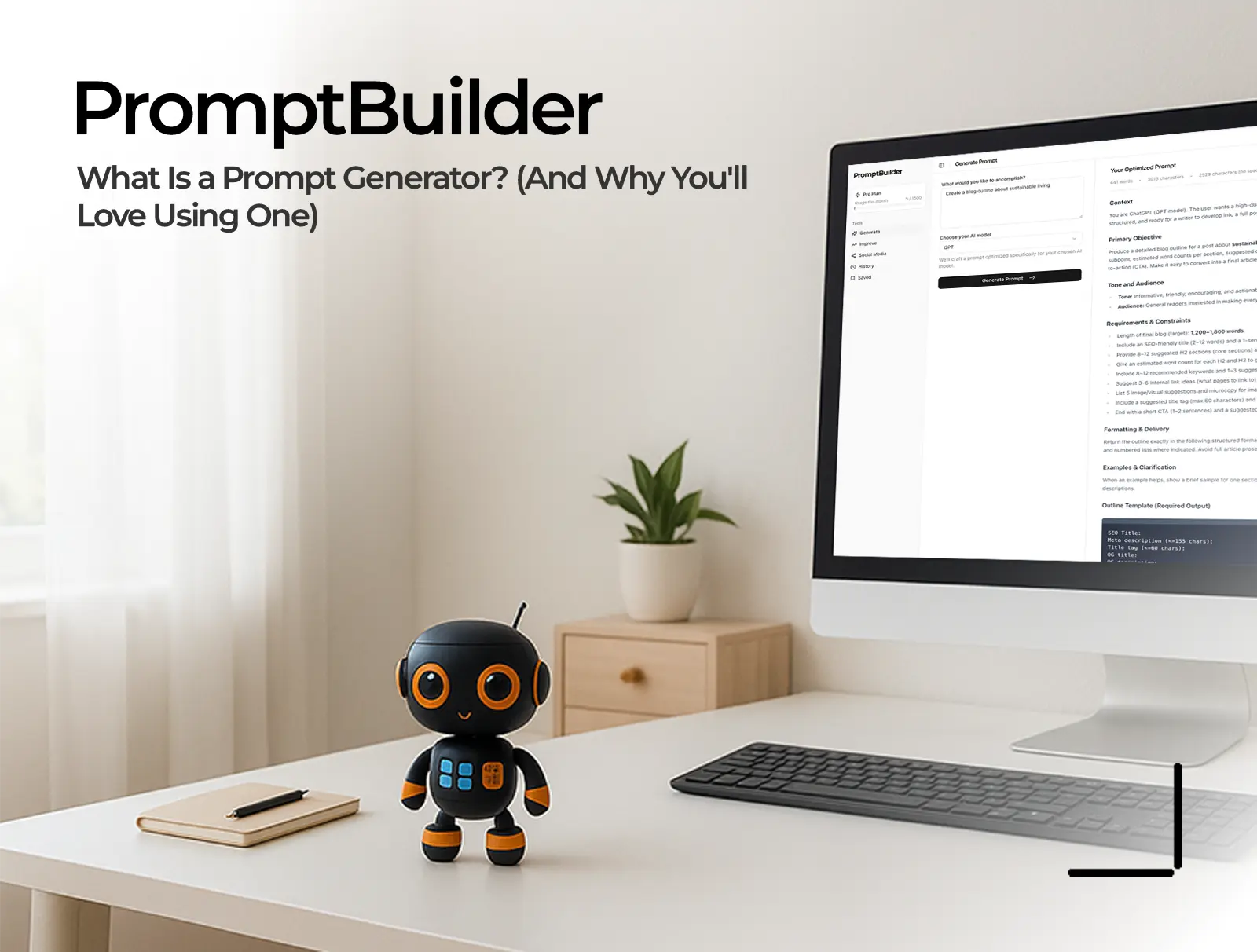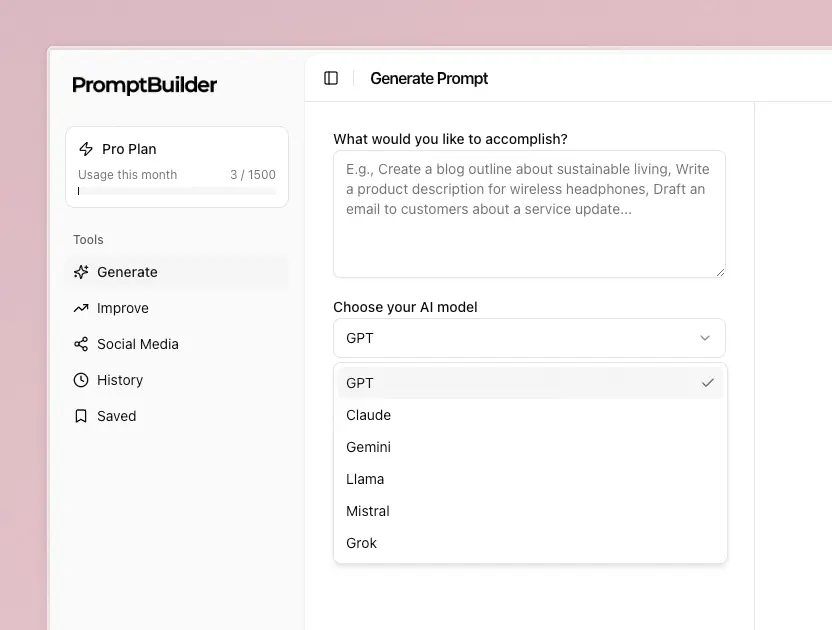Prompt Engineering: The Complete Beginner's Guide (2025)
If you've ever wondered why some people get amazing results from AI while others struggle with vague, unhelpful responses, the secret lies in prompt engineering. This fundamental skill has become the difference between casual AI users and those who unlock its true potential for business, creativity, and problem-solving.
Whether you're completely new to AI or looking to improve your results with ChatGPT, Claude, and Gemini, this comprehensive guide will teach you everything you need to know about prompt engineering—from basic concepts to advanced techniques you can implement immediately.
🚀 Ready to practice prompt engineering? Try our ChatGPT Prompt Generator to create optimized prompts instantly, or explore our dashboard to test the copy-paste prompts included in this guide.
What Is Prompt Engineering? (Meaning and Definition)
Prompt engineering is the practice of writing clear, constrained instructions that guide large language models (LLMs) toward specific, reliable outputs. Good prompts spell out the task, audience, constraints, examples, and the output format (often JSON) to reduce ambiguity.
Think of prompt engineering as programming in natural language—you're providing precise instructions that tell the AI exactly what you want, how you want it, and in what format. The better your "code" (prompt), the better your output.
Why Prompt Engineering Still Matters in 2025
Despite AI models becoming more sophisticated, vendor documentation from major platforms consistently shows that clear instructions, concrete examples, and structured outputs improve consistency in real applications:
- Google Cloud: Emphasizes specificity and structured prompting for enterprise applications
- IBM: Highlights the importance of constraint-setting and example-driven prompts
- OpenAI Platform: Demonstrates how proper formatting and iteration improve results
- Anthropic: Shows that clear context and safety guidelines enhance Claude's performance
Key insight: Even the most advanced AI models in 2025 perform significantly better when given well-engineered prompts rather than casual conversational inputs.
Core Principles for Immediate Success
Master these four fundamental principles to see instant improvement in your AI interactions:
1. Be Specific About Everything
Poor example: "Help me with marketing" Good example: "Create a 30-day LinkedIn content calendar for a B2B SaaS startup targeting small business owners, focusing on productivity tips and thought leadership"
Specify your task, target audience, desired tone, constraints, and success criteria. Vagueness leads to generic outputs.
2. Use Examples When Quality Matters (Few-Shot Prompting)
This proven technique has been effective since GPT-3's early days. Provide 2-3 examples of your desired output format or style:
Write product descriptions for our e-commerce site:
Product: Wireless headphones, $199, noise-canceling
Description: "Escape into pure sound with our premium wireless headphones. Advanced noise-canceling technology blocks distractions while delivering crystal-clear audio for work, travel, or relaxation."
Product: Ergonomic office chair, $299, lumbar support
Description: "Transform your workspace with professional comfort. This ergonomic chair provides all-day support with adjustable lumbar cushioning and premium materials built for lasting durability."
Now write a description for: Smartwatch with fitness tracking, $249, heart rate monitor
3. Ask for Structured Outputs
Request specific formats (JSON, bullet points, numbered lists) so you can parse and evaluate results consistently:
Analyze this customer feedback and return results as JSON:
{
"sentiment": "positive|negative|neutral",
"key_themes": ["theme1", "theme2"],
"priority_score": 1-10,
"suggested_action": "specific recommendation"
}
4. Iterate and Refine
Test variations, measure results, and refine your approach. The best prompts evolve through systematic testing and improvement.
Key takeaway: Prompt engineering success comes from applying these principles systematically, not randomly trying different approaches.
7 Copy-Paste Prompts for PromptBuilder
These production-ready prompts are designed to work seamlessly with PromptBuilder's Generate Prompt feature. Each returns structured outputs you can trust and easily integrate into your workflows.
How to use: Open Generate Prompt on PromptBuilder → paste one of these into the instruction/system box → add your specific content → run.
1. Universal Task Handler (JSON Output)
You are a precise assistant.
Task: {describe what you want, for whom, and why}.
Constraints: {tone, reading level, word count, do/don't}.
Context: {bullet facts or excerpts the model MUST use}.
Return ONLY valid JSON:
{
"summary": "",
"key_points": [],
"draft": ""
}
Validation rules:
- Use the context faithfully; do not invent facts.
- If context is insufficient, set "draft" to "" and add a missing_info note in "key_points".
Best for: Any task requiring reliable, structured output with fact-checking
2. Writing Assistant with Categorized Suggestions
You are a writing editor. Given the user's text, find issues in five categories:
Grammar, Spelling, Punctuation, Style, Clarity.
Return ONLY JSON:
{
"suggestions": [
{"category":"Grammar|Spelling|Punctuation|Style|Clarity",
"message":"short explanation",
"start":0, "end":0,
"replacement":"replacement text or '' if none"}
]
}
Rules: keep tone; minimal edits; no rewrites unless required; empty list if nothing to fix.
Best for: Content editing and proofreading workflows
3. Summarize and Rewrite with Tone Control
Role: senior editor.
Goal: produce a crisp summary AND a rewritten version in the requested tone.
Inputs: user's text + {tone} + {target_length_words}.
Return ONLY JSON:
{"summary":"...", "rewrite":"...", "notes":["..."]}
Rules: preserve meaning; cite terms from input; cap rewrite length to target_length_words ±10%.
Best for: Content adaptation for different audiences and formats
4. Structured Data Extraction (Strict Schema)
Extract the following fields from the user's text and return ONLY JSON matching this schema:
{
"company": "",
"contact": {"name":"", "email":"", "title":""},
"intent": "demo|pricing|support|other",
"date_iso": ""
}
Rules:
- If a field is missing, return "" (or "other" for intent).
- Never guess emails or dates.
- Validate date to ISO 8601 when present.
Best for: Lead processing, contact management, and data extraction
5. SEO Blog Outline Generator
You are an SEO editor.
Topic: {your topic}. Audience: {beginner/intermediate}.
Constraints: H2/H3 only, no fluff, include FAQs aligned to search intent.
Return ONLY JSON:
{"title":"", "slug":"", "h2":[{"title":"", "h3":["",""]}], "faqs":[{"q":"", "a":""]}]}
Rules: include definitions, how-to steps, pitfalls, and an evaluation checklist.
Best for: Content planning and SEO optimization
6. Course Syllabus Creator
Design a 4-week beginner course on prompt engineering.
Each week: learning goals, 3–5 lessons, hands-on exercises, and an assessment.
Return ONLY JSON:
{
"weeks":[
{"title":"", "goals":[""], "lessons":[""], "exercises":[""], "assessment":""}
],
"outcomes":["",""]
}
Focus areas: clarity, few-shot examples, structured outputs, evaluation & iteration.
Best for: Training program development and curriculum planning
7. Prompt Evaluator and Test Harness
Given a target task description and 2–4 candidate prompts, generate test cases
(inputs + expected properties) and score each prompt (0–10) against clarity,
faithfulness, and structure.
Return ONLY JSON:
{"cases":[{"input":"", "notes":[""]}],
"scores":[{"prompt_id":"A","clarity":0,"faithfulness":0,"structure":0,"rationale":""}]}
Rules: do not leak answers into inputs; highlight failure modes and ambiguity.
Best for: Prompt testing and optimization workflows
Pro tip: These prompts are model-agnostic and work well across ChatGPT, Claude, and Gemini. The structured outputs make integration and evaluation much easier.
Quick Learning Path (Free Resources)
Ready to dive deeper? Here's a systematic approach to mastering prompt engineering:
Week 1: Foundations
- Start with vendor documentation: Review Google AI for Developers and Anthropic's prompt design pages to learn fundamental patterns and best practices
- Practice basic structure: Apply the core principles (specificity, examples, constraints, format) to 5-10 different tasks
- Focus on clarity: Write prompts that eliminate ambiguity and clearly communicate your intent
Week 2: Advanced Techniques
- Master few-shot prompting: Add 1–3 high-quality demonstrations to your prompts for complex tasks
- Learn structured outputs: Practice requesting JSON, tables, and formatted responses
- Study successful patterns: Analyze prompts that work well and identify reusable elements
Week 3: Hands-On Practice
- Take the free course: Enroll in ChatGPT Prompt Engineering for Developers by DeepLearning.AI (Andrew Ng & Isa Fulford) for comprehensive hands-on experience
- Build a prompt library: Save and organize your successful prompts for future use
- Test across models: Try the same prompts on different AI platforms to understand their unique strengths
Week 4: Optimization and Integration
- Implement iteration loops: Develop a systematic process for testing and refining prompts
- Measure performance: Track success rates, quality scores, and cost efficiency
- Scale your approach: Create templates and workflows for common use cases
Key insight: Consistent practice with real projects accelerates learning more than theoretical study alone.
Frequently Asked Questions
What does "prompting" mean in AI?
Prompting is simply giving instructions to an AI model. Prompt engineering is doing that deliberately—with structure, examples, and constraints—to improve reliability and achieve consistent, professional results. It's the difference between casual conversation and strategic communication.
Do I always need JSON and structured outputs?
Not always, but structured outputs make applications far easier to test, integrate, and scale. If you're building anything beyond casual experimentation, structured formats save significant time and prevent integration headaches. Start with JSON for important workflows.
What's the fastest way to get better at prompt engineering?
Follow the iteration cycle: write → run → inspect → refine. Add examples when outputs drift from your expectations, and build a library of successful patterns. Most improvement comes from systematic practice rather than studying techniques in isolation.
Which AI model is best for prompt engineering practice?
All major models (ChatGPT, Claude, Gemini) work well for learning, but each has strengths:
- ChatGPT: Excellent for creative tasks and conversational prompting
- Claude: Superior for analytical tasks and long-form reasoning
- Gemini: Strong for research tasks and factual accuracy
Start with whichever model you use most frequently, then expand to others.
How do I know if my prompts are working well?
Track these key metrics:
- First-try success rate: How often you get usable results without revision
- Consistency: Whether similar inputs produce similar quality outputs
- Time savings: Reduction in manual work or revision cycles
- Output quality: Relevance, accuracy, and adherence to your specifications
🎯 Ready to Master Prompt Engineering?
Stop settling for mediocre AI outputs. These techniques and templates will transform your AI interactions from frustrating experiments to reliable, professional workflows.
Start practicing today:
- Try our ChatGPT Prompt Generator: Create optimized prompts instantly
- Test the copy-paste prompts: Use our Generate Prompt feature to try the 7 templates from this guide
- Explore more free tools: Access our complete suite of prompt optimization tools
For serious results: Upgrade to PromptBuilder Premium and join thousands of professionals who rely on our advanced prompt optimization platform for consistently superior AI results.
Don't let poor prompts limit your AI potential. Master prompt engineering and unlock the full power of AI in your work and business.

